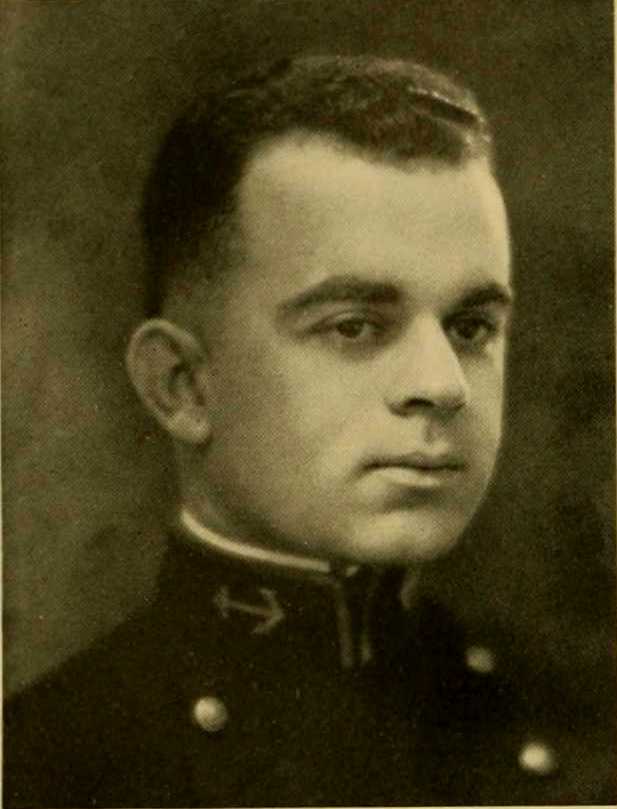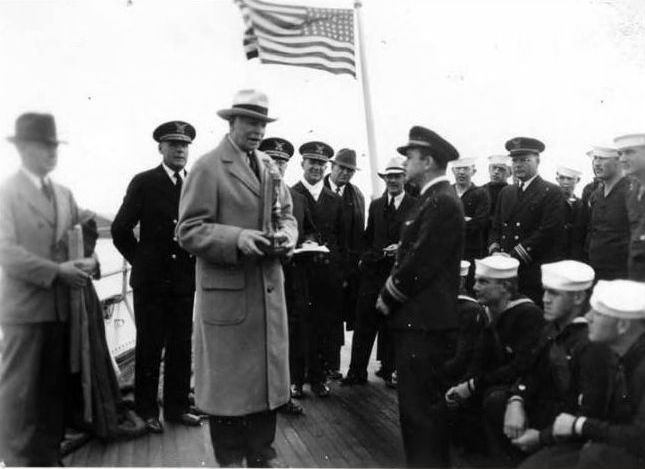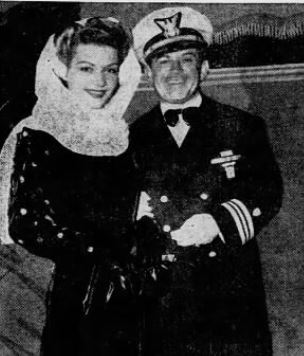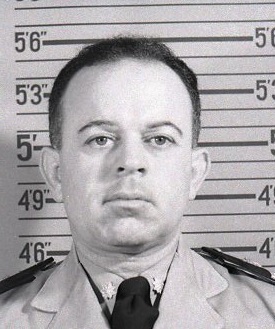Born in Morro Castle, Puerto Rico, on February 17, 1903, Henry Frederick Garcia would become a trailblazer in the history of the Coast Guard.
Garcia came from a prominent military family. His father had a career in the U.S. Army and his younger brother would retire as a rear admiral in the U.S. Navy. Garcia lived in military installations in Puerto Rico and Ohio before receiving an appointment to the United States Naval Academy. In 1924, after graduating from the Academy, he accepted a commission in the U.S. Army and served in field artillery until 1928, when he accepted a commission in the United States Coast Guard.
As the first Hispanic-American officer in the Coast Guard, Ens. Garcia would start his career during Prohibition. At that time, several Navy destroyers were transferred to the Coast Guard and Garcia would learn the craft and life of a Coast Guard officer on board them. The experience he garnered during these afloat assignments came in handy throughout his storied career.
As with any Coast Guardsman, Garcia faced several watershed moments in his career. In 1936, he was assigned as engineering officer aboard the Cutter Shoshone. In this capacity, he was a witness to history as the cutter helped lay groundwork for aviator Amelia Earhart’s historic circumnavigation of the globe. In March 1937, Shoshone departed Oakland, California, and headed to the South Pacific where it offloaded fuel vital to Earhart’s landing at Howland Island. Had Earhart reached Howland, the stores provided by Shoshone would have allowed Earhart to continue her historic flight, but she disappeared before that happened.
In 1939, Lt. Garcia made history as the first Hispanic American to command a Coast Guard cutter when he became the commanding officer of the Cutter Morris stationed in Seward, Alaska. His tour in Alaska would prove to be very eventful for Garcia. In March, he led a daring rescue of trappers on Tugidak Island. Given up for dead a month earlier, the survivors subsisted off rotten fish and were nearly incapacitated. After weeks of searching for the missing men, Garcia located the survivors. Before an evacuation could take place, Garcia had to keep the Morris afloat during a 48-hour gale. With the situation becoming direr by the minute, Garcia decided to launch the small boat into the seas, rescuing the men before they expired.
The adventures continued in June with Morris dispatched to oversee the evacuation of victims near the Mount Veniaminof eruption. Garcia and his crew stood by for a few weeks to monitor the fishing fleet, while the mountain spewed fire and ash 20,000 feet into the air. After the main eruption on June 17, Garcia and his crew put in for Perryville, Alaska, to evacuate 14 people remaining in the town, but the residents refused to leave. He would not force them to evacuate, so Garcia sailed for Chignki and maintained constant radio contact with Perryville throughout the duration of the event, ensuring the safety of all involved.
With little chance to recover from their mission to Mount Veniaminof, word came of a vessel in distress. An expedition to find an ice-free Northwest Passage, led by Dr. Homer Flint Kellems, radioed a distress call. After making its way north for two weeks, the expedition’s vessel, Schooner Pandora, had struck a rock three miles north of St. Elias and suffered catastrophic damage. Upon hearing the distress call, Garcia steamed from Seward at best possible speed to reach the stricken vessel. When the Morris arrived, the rain-soaked crew of Pandora was salvaging what little was left of ship and cargo. After assessing the situation, Garcia rescued the beleaguered crew from Kayok Island and brought them back to safety after their harrowing ordeal.
After departing Alaska, Garcia served wartime duty in assignments on both East and West coasts. In Charleston, Garcia served as executive officer of Base Charleston, where he participated in the seizure of the Italian cargo vessel Villaperosa in March 1941. Following a presidential order to seize all Axis Powers’ shipping, Garcia and his team discovered the Italian crew of the Villaperosa had sabotaged their freighter. Their intent was to ensure that the ship would be of no use to the U.S. after its seizure. The crew smashed the power plant and threw scrap metal into the blocks while the engines were running. Garcia’s team secured the ship and its crew and collected evidence against the saboteurs. As for the crew, they were found guilty of sabotage and imprisoned for seven years. Meanwhile, the Villaperosa was towed to New York, repaired, and put back into service for the U.S.
Departing Charleston shortly after the attack on Pearl Harbor, not Lt. Cmdr. Garcia served in Baltimore, with the Military Sea Transportation Service, until he was reassigned to Captain-of-the-Port Los Angeles. In this role, he was responsible for the security of the port as Assistant Captain of the Port. Garcia maintained his exemplary leadership by overseeing the creation of units maintained and led by the female volunteer force, Semper Paratus, Always Ready, or SPARs and was the face of the Coast Guard in Los Angeles during the waning years of the war. Sometime after this assignment, for reasons yet unknown, Henry Frederick Garcia changed his name to Montegue Frederick Garfield.
Garfield, as he was now known, travelled to Galveston, Texas, to become the first minority commanding officer a Navy patrol frigate, the Coast Guard-manned USS Annapolis. In September 1945, after escorting several convoys to Oran, Algeria, Annapolis shifted station to Seattle. Shortly after arriving in Seattle, Garfield’s opportunity for greatness struck again. While on patrol, the Annapolis was dispatched to Ketchikan, Alaska, to rescue the passenger vessel SS Prince George. Arriving on scene, Cmdr. Garfield and his crew fought a massive blaze consuming the Prince George. Under Garfield’s leadership, Annapolis’s crew kept the blaze at bay rescuing the 113 crew and passengers aboard. Under Garfield’s command, the patrol frigate then towed the vessel to Gravina Island where it was beached and later scrapped.
Within months, Garfield would leave command of the Annapolis and finish his underway career as commanding officer of the high-endurance cutter Campbell, homeported in Charleston. Shortly after arriving, Garfield found himself in the presence of history once again, this time with “Sinbad,” Chief Petty Officer-Dog. Never one to steal the spotlight, Garfield ensured that Chief Sinbad got a hero’s welcome upon the cutter’s arrival in New York in January 1946. Garfield even allowed for an “interview” with Chief Sinbad by radio station WTMA in Campbell’s wardroom.
After finishing his career at sea, Garfield assumed the role of Chief of Public Affairs for the Coast Guard’s Eighth District in New Orleans. Always one to put others before himself, he answered a young man’s letter wishing to support his country as a member of the Coast Guard. Only one issue lay in front of Philip Flathouse from Texas, he was merely 10 years old. Rather than dismiss the youth outright, Garfield wrote the young man back and laid out a plan for him to join the service in seven years when he was old enough to join. Whether the boy joined the Coast Guard is unknown, but he made an impression on Garfield.
Montegue Garfield retired as a captain in 1956 after five years as the Chief of Intelligence at Coast Guard’s 12th District in San Francisco. Garfield had become a minority trailblazer. He was the first Hispanic-American officer in the Coast Guard at every rank from ensign to captain. He was also the first Hispanic-American officer to serve in a variety of ashore and afloat assignments, including the first to command a medium-endurance cutter, high-endurance cutter and Coast Guard-manned Navy vessel. And, while famed African-American Revenue Cutter Service captain Michael Healy deserves credit as the first minority officer in the U.S. sea services, Garcia may claim the title of first minority officer to serve in the modern Coast Guard.
After retirement, Montegue Frederick Garfield moved to San Diego where he engaged in the real estate business. He died on June 26, 1966, at the age of 63. A career cutterman and minority trailblazer, he is most assuredly a distinguished member of the long blue line.
 |
|
 |
|
Photo of Midshipman Henry Frederick Garcia in the yearbook of the United States Naval Academy. (U.S. Navy)
|
|
Faded newspaper article photo showing Lt. Henry Garcia (second from left) in dress whites with the officer corps on board Coast Guard cutter Shoshone. (Honolulu Advertiser)
|
 |
|
 |
| Picture of Lt. Henry Garcia on the fantail of Coast Guard Cutter Shoshone at a formal ceremony receiving the trophy for winning the Coast, Bering Sea Patrol Force rowing competition. Photo shows officers, man and dignitaries from competing cutters and Alaska. (photo by Alan May) |
|
Newspaper photograph showing Lt. Cmdr. Henry Garcia in his dress blue uniform with Hollywood starlet Mary Moore. (Los Angeles Times)
|
 |
|
 |
|
A World War II photo, showing Lt. Cmdr. Garcia with two Coast Guard SPARs and Los Angeles mayor Fletcher Bowron. Garcia presents Bowron with a Coast Guard identification card from the Identification Bureau of the Coast Guard Captain of the Port office in Los Angeles. (Los Angeles Times)
|
|
Coast Guard identification photograph of Cmdr. Montegue Garfield. (U.S. Coast Guard)
|
 |
|
Photo of USS Annapolis responding to the burning SS Prince George in Ketchikan, Alaska, signed by Cmdr. Garfield. (National Archives)
|